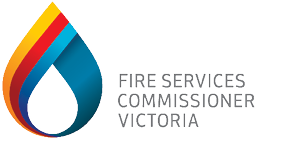
Fire Services Commissioner for Victoria

The establishment of a Fire Services Commissioner as an independent statutory appointment reporting directly to the Minister for Police and Emergency Services, adds a different dimension to fire management in Victoria.
The focus of the Fire Services Commissioner is on developing an integrated fire ready force, an integrated network of partner organisations outside the traditional emergency services organisations and a fire ready and safe community.
The potential to improve the way Victoria’s three fire services operate together was a key theme highlighted throughout the 2009 Victorian Bushfires Royal Commission and the Fire Services Commissioner Act 2010 is explicit in pursuing interoperability as the way business is conducted in Victoria.
One of the key mechanisms in achieving this is focused on ensuring the operating systems and practices between Victoria’s three fire agencies are interoperable, so that when the state’s fire agencies prepare or respond together they can do so seamlessly and with optimal effectiveness.
Interoperability is a complex issue and much more complicated than turning a toggle on a radio. It is about creating an attitude and environment of cooperation to deliver the highest level of service to the community.
An interoperability model has been developed to document the five pillars that are fundamental in achieving this. The pillars of the interoperability model are Governance, Doctrine, Enablers (Technology), Training/Exercising and Application and Usage (Service Delivery).
Governance is the cornerstone of the model, and establishes the authority and expectations for the agencies to operate as a joined up unified force. The Fire Services Commissioner’s Act establishes this setting.
Doctrine is the principle of operations that underpin the mode of operation. In an interoperable model, these are the beliefs that are commonly held and shared and that augment the governance.
Enablers include the systems and technology that support the agencies to work together. The interoperability model supports common systems to deliver common situational awareness through common data, information and intelligence. Training and Exercising are the pillars that strengthen relationships, enhance performance, and form a key ingredient in delivering on interoperability. Training and Exercising must extend past the agency level and include private sector partners and the community
Finally, the application and usage (service delivery) is the key measurable that will ensure effective and efficient delivery to the community by the agencies with the aim of building community capability and capacity to improve their resilience and preparedness.
It is also about partner agencies, organisations being embedded into any preparedness or operational activity and driving and supporting relevant improvement. And it is about the fire services working together striving to continually improve and adapt service delivery.
Everything the fire services – and emergency service partners - do must be measured by the value that is ultimately added to community safety and this involves understanding how emergency services can best help the community member who stands knee deep in water at his back door or who has a fire at their back fence.
After 30 years in emergency services management and emergency response with the CFA, VicSES and Department of Human Services, I’m a strong believer in the integration of the community into all levels of emergency management in an all hazards, all agencies approach.
A resilient community is one which is involved, which has well rehearsed emergency plans, which works together with local leaders. And providing the community with the information they need, and in a way they understand so they can prepare and make their own informed choices has to be our priority.
As part of the 2010/11 fire season, the provision of community information and warnings was elevated to the same importance as the operational aspect of fighting fires. In some instances, it’s importance actually surpasses firefighting efforts.
Strategic control priorities were issued to incident controllers to provide guidance and outline that protection and preservation of life is paramount - including the safety of emergency services personnel as well as community members.
Secondly, the strategic control priorities outline the need for community information and warnings that are timely, relevant and tailored to help the community make informed decisions about their safety.
While the 2010/2011 Victorian fire season was relatively mild, the strategic control priorities had also been adopted for flood and storm by the Victoria State Emergency Service.
Other Australian states are watching Victoria with interest as a result of the events of February 7 2009. As the incidence of natural disasters increase Australia-wide, the importance of interoperability and a community that has capacity and feels confident in their own ability will only become more important.
Beginning his career as a volunteer firefighter, CraigLapsley rose through the ranks of the Country Fire Authority (CFA) to become a Deputy Chief Officer.
He has both interstate and interagency experience, having overseen state operations in the NSW Fire Brigade and also transformed the Victorian State Emergency Services (SES) from a government department to a statutory authority
In 2007, Craig left the CFA to become Director Emergency Management, Health and Human Services, playing a lead role in Victorian recovery efforts following the 2009 Black Saturday bushfires.
Craig became Victoria’s first Fire Services Commissioner in 2010, a role recommended by the Bushfires Royal Commission. An independent statutory position, the Commissioner is the State Controller for major fires in Victoria and the most senior operational firefighter in the state.
